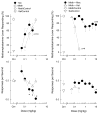Nicotine and methamphetamine share discriminative stimulus effects
- PMID: 17961933
- PMCID: PMC2377183
- DOI: 10.1016/j.drugalcdep.2007.08.020
Nicotine and methamphetamine share discriminative stimulus effects
Abstract
Background: Nicotine and methamphetamine are both abused in similar settings, sometimes together. Because there are known interactions between central nicotinic acetylcholine receptors and dopamine receptors, it is of interest to characterize the nature of the interaction of these two compounds in vivo.
Methods: The purpose of this study was to characterize the extent to which these two compounds produce similar discriminative stimulus effects and to identify pharmacological mechanisms for their interaction. Male Sprague-Dawley rats were trained to discriminate methamphetamine or nicotine from saline. First, the ability of methamphetamine and nicotine to cross-substitute in rats trained to the other compound was tested. Subsequently, the ability of a dopamine antagonist (haloperidol) and a centrally acting nicotinic antagonist (mecamylamine) to block the discriminative stimulus effects of methamphetamine and nicotine were also tested.
Results: Nicotine fully substituted in methamphetamine-trained rats, but methamphetamine only partially substituted in nicotine-trained rats. In nicotine-trained rats, mecamylamine fully antagonized the discriminative stimulus effects of nicotine, but haloperidol had no effect. The partial substitution of methamphetamine was partially attenuated by haloperidol, but not altered by mecamylamine. In methamphetamine-trained rats, mecamylamine failed to antagonize the discriminative stimulus effects of methamphetamine, but haloperidol fully blocked the methamphetamine cue. Mecamylamine blocked the ability of nicotine to substitute for methamphetamine, but haloperidol had no effect.
Conclusions: These results indicate that nicotine and methamphetamine share discriminative stimulus effects in some subjects and that the two compounds do not act at the same site, but produce their interaction indirectly. These findings suggest that these two compounds might be at least partially interchangeable in human users, and that there are potentially interesting pharmacological reasons for the commonly observed co-administration of nicotine and methamphetamine.
Figures



References
-
- Balster RL. Drug abuse potential evaluation in animals. British Journal of Addiction. 1991;86:1549–1558. - PubMed
-
- Corrigall WA, Coen KM. Dopamine mechanisms play at best a small role in the nicotine discriminative stimulus. Pharmacology Biochemistry and Behavior. 1994;48:817–820. - PubMed
-
- Czoty PW, Ramanathan CR, Mutschler NH, Makriyannis A, Bergman J. Drug discrimination in methamphetamine-trained monkeys: effects of monoamine transporter inhibitors. J Pharmacol Exp Ther. 2004;311:720–727. - PubMed
-
- de la Garza R, Johanson CE. The discriminative stimulus properties of cocaine in the rhesus monkey. Pharmacology Biochemistry and Behavior. 1983;19:145–148. - PubMed
-
- de la Garza R, Johanson CE. Discriminative stimulus properties of cocaine in pigeons. Psychopharmacology. 1985;85:23–30. - PubMed
Publication types
MeSH terms
Substances
Grants and funding
LinkOut - more resources
Full Text Sources
Medical

